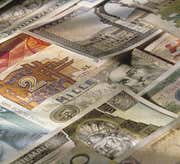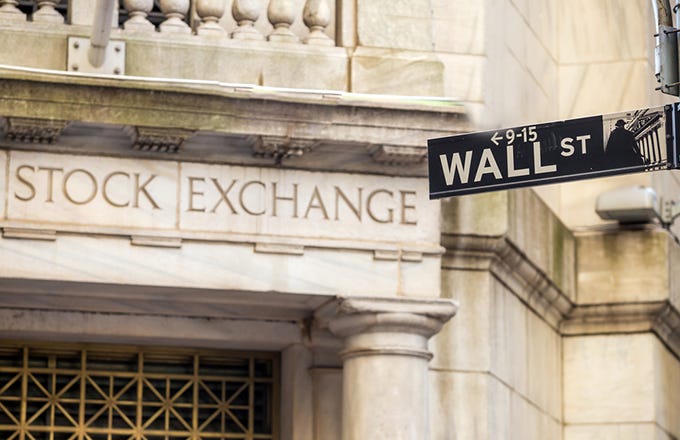Price skew is a term referring to the inequity in implied volatility (IV) levels across individual options strikes. When options prices are used to compute IV, it becomes apparent from a look at all the individual option strikes and associated IV levels that the IV levels for each strike are not always the same. In fact, there are patterns to this IV variability.
If you have experience trading options, it’s likely that you’ve seen IV values for a particular stock before. These are typically derived from an average of all strikes or near the money strikes, or even at-the-money strikes of the nearest trading month. If you take a closer look, though, as we will in this chapter, the variability of IV along the option strike chain shows what is known as an IV skew.
Skews are categorized in two ways: they can be either horizontal or vertical. We’ll explore the vertical skew first. In this case, you’ll see how volatility changes depending upon the strike price. After that, we’ll look at an example of a horizontal skew, which refers to a skew across time (that is, options with different expiration dates).
Forward and Reverse Skews
Vertical IV skews can be further split into two types. There are forward (positive) and reverse (negative) skews. Options on stock market indexes (i.e. OEX, SPX) have a permanent reverse IV skew. This particular pattern of IV variability is common across most equity market indexes, as well as for many of the stocks which make up those indexes.
In a reverse vertical IV skew, at lower option strikes IV is actually higher, and at higher option strikes it is lower. Figure 1 shows an example of a reverse IV skew on the S&P 500 index call options.
 |
| Generated using OptionVue 5 Options Analysis Software. |
| Figure 1: Reverse IV skew on S&P 500 index call options. IV falls moving from lower to higher points on the strike price chain, as seen in the IV levels highlighted in yellow. |
The first of the three data columns (next to the strikes) in the figure above contains option market prices, and the far-right column contains time premium on the options. The arrows drawn in above the chart point to the higher and lower strikes for each expiration month with associated IV levels, indicating vertical reverse skews.
If you know what to look for, it’s easy to identify the vertical reverse skew in Figure 1. For example, the August 1440 call option has an IV of 28.21%, as compared with the lower IV on the higher August 1540 call strike, which has an IV of 23.6%. The lower the options on the strike chain (either calls or puts), the higher the IV will be.
Figure 1 also includes September options, and the skew can be seen in these figures as well. Note that the IV levels across time (in this case, for August vs. September) are not the same on these strikes. Rather, the front month August options have a higher level of IV. This anomaly is known as a horizontal skew, which we’ll explore later on.
Figure 2 below contains IV levels on S&P 500 stock index put options (for the same day as for Figure 1). In this chart, the IV on August 1460 put strike is 26.9%. As you move down the strike chain, though, IV rises to 37.6%, as we can see for the 1340 put strike. These IV levels reflect the close of trading following a significant drop of 44 points in the S&P 500 for August 9, 2007. The skew is always there, but it intensifies or lessens depending upon where it is relative to the market drop (in this case, it has intensified following the drop). The reverse or forward skew exists mostly in response to the possibility of a crash in the market which may not be captured in standard pricing models. Put differently, risk is priced into the options to take into account the possibility, even if very remote for any particular time, of a large market decline.
 |
| Generated using OptionVue 5 Options Analysis Software |
| Figure 2: Reverse IV skew on S&P 500 index put options. IV falls moving from lower to higher points on the strike price chain, as seen in the IV levels highlighted in yellow. |
In Figure 3, we see a vertical forward skew on March coffee options. In this case, at lower option strikes IV is lower and at higher option strikes IV is higher.
 |
| Generated using OptionVue 5 Options Analysis Software |
| Figure 3: Forward (Positive) IV skew on March Coffee call options. IV levels rise at higher points on the strike price chain. |
In the case of commodities, typically IV rises higher on higher strikes as a result of the perceived risk of a price explosion to the upside resulting from a sudden supply disruption. IV levels may increase on out-of-the-money calls, for instance, if there is an increasing possibility of a frost which might disrupt the supply. If the event doesn’t take place, IV levels are likely to quickly fall to more normal ranges.
The skews identified in the above figures may best be characterized as “smirks,” but one can also find different patterns of variability. They sometimes resemble a “smile,” meaning that the IV levels on out-of-the-money puts and calls are elevated relative to the near or at-the-money options. This situation arises on occasion when corporate news announcements are anticipated, or pending news of a nature that may result in a big move in either direction for a stock. The reverse skew which we saw in the first two figures above, on the other hand, is always present, though relative and absolute levels of the IV on the strikes change depending upon levels of investor fear at any point in time.
Horizontal Skews
In Figure 4 below, a horizontal skew is evident for March coffee call options. We see a 5% difference in IV levels from the Dec. 155 call options and Mach 155 call options, and the front month has higher levels. Generally, it’s possible for options in any one month to develop higher IV levels than for other months. This is true for stocks as well as commodities. This typically happens as a result of expected price moves which surround an impending news event or, in the case of commodities, because of weather or supply conditions which may impact price. These skews arise and disappear as a news event approaches and then passes, in most cases.
 |
| Generated using OptionVue 5 Options Analysis Software |
| Figure 4: Horizontal IV skew on March coffee call options. IV for December out-of-the-money call options has a forward positive skew. The options are also trading at higher IV levels than their counterparts in March (i.e., 155 call options). |
The Bottom Line
In this chapter, we’ve explored a number of types of option IV skews. Specifically, we looked at the reverse skew, the forward skew, and the horizontal skew. These are common types of skews which can be found in option markets. In the real world, the exact shape of the skew varies, although the basic structures are destined to repeat again and again. A trader may employ strategies to identify skews in order to optimize the IV pricing as well as to determine possible changes in skew pricing which may occur when the skew disappears.
Option Volatility: Predicting Big Price Moves
-
 Investing
InvestingWhat's Skewness?
Skewness describes how a data distribution leans. -
 Trading
TradingProfiting From Position-Delta Neutral Trading
This trading strategy will show you how to gain from a decline in implied volatility. -
 Investing
InvestingKey Market Risk Measure Highest in 28 Years
Investors are actively hedging against a major market meltdown. -
 Investing
InvestingTransCanada Sits In Oil Pipeline Catbird Seat
TransCanada stands to win no matter what happens to the Keystone XL Pipeline. Approved? Send oil to a thirsty America. Shot down? Send it west to tankers. -
 Insights
InsightsBe Afraid! Volatility & Fear Measures Back to Brexit Levels
Safe-haven assets on the rise as volatility increases and geopolitical tensions grow.



